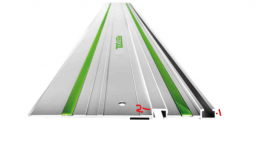This is bit more complicated as one needs to understand how the physics of extrusion production work as that is what defines what will be accurate and where will be a variance. This is a universal comment, irrespective of the rail make.
Some basics:
- it is extremely difficult /read: impossible/ to ensure the "size" (think width and height, not length) is consistent BETWEEN manufacturing runs
- it is easy to ensure ONE surface of your extrusion has almost no bends and so is mostly straight, class 1 engineer's straight edge straight, but the other surfaces will vary based on the varying width/height of the extrusion in relation to that "reference" surface
- it is relatively easy - within a single extrusion production - to ensure the width WITHIN this extrusion is pretty consistent, this is because the biggest problem is not that specific piece, but the variance in the aluminum material composition as it comes from the mill
What this translates to in laymen's terms:
- manufacturer can choose a surface which he will setup the extruder to produce as straight as possible /at the expense of the other surfaces/
- manufacturer can STILL ensure that surfaces parallel with the reference surface will be "very much parallel" and very close to the straightness of the reference surface, just even so slightly worse than the reference surface precision
- manufacturer CANNOT ensure all produced rail - even those produces on the same machine during the same day - will be the same width /I have observed close to 0.2 mm (0.01") difference between new rails inner and outer rib "1" and "2" surfaces distance/
What this translates to in practical use:
- for max precision when joining, always use the reference surface
- using the "far/outer" surface for squaring is very much fine /hence GRS practical accuracy/
- using the "far/outer" surface for distance/width reference is NOT gonna produce consistent results when using joined rails as those can have slightly different widths
- using the "ribs" relative position to each other for aligning the rails will produce hit/miss results depending how lucky one was in the "widths lottery" when buying his rails
Hope helps.
P.S.:
When I say this post is universal, I mean that the relative comparisons - where is accuracy and where is inaccuracy potential - will be so with any extrusion /rail/ maker. One would have to go with a milled rail to change this. There are and will be differences in how precise each maker makes his rails.
But what is the same is that the biggest "issue" /besides alignment/ when joining extruded rails is always the varying width. And the most important property indicating "quality/accuracy" of a rail is always the "saw-guiding" rib straightness as that is what guides the saw. Heh.
The rib-outer to rib-outer width within a rail is something worth checking with a caliper when buying, but will generally be in the "good enough" territory so squares using the outer edge are fine. Actually best possible, as that is the straightest "accessible" surface given the reference rib has a saw riding on it ...

